Key Terminology
Importance of Risk Management
Risk management is crucial because it helps traders avoid significant losses that can lead to emotional decision-making and potentially wipe out trading accounts. By implementing sound risk management practices, traders can stay disciplined and consistent, enhancing their chances of long-term success.
- Capital Protection: Ensures that losses do not exceed manageable levels.
- Emotional Stability: Helps prevent emotional decision-making during market volatility.
- Long-Term Survival: Increases the chances of staying in the market over the long term.
- Consistent Performance: Promotes steady, reliable trading results.

Tools and Techniques
Stop-Loss Orders
Stop-loss orders are pre-defined levels at which a trade will be automatically closed to prevent further losses. This tool is essential for protecting your capital and maintaining discipline in your trading strategy.
- Example: If you buy a currency pair at 1.3000, you might set a stop-loss order at 1.2950 to limit your potential loss to 50 pips.
Take-Profit Orders
- Example: If you sell a stock CFD at $100, you might set a take-profit order at $95 to secure a profit if the price drops.
Position Sizing
- Example: You might decide to risk only 2% of your trading account on any single trade, adjusting the position size accordingly based on the stop-loss level.
Risk-Reward Ratio
- Example: A trade with a stop-loss of 20 pips and a take-profit of 60 pips has a risk-reward ratio of 1:3, meaning the potential reward is three times the risk.
Take-Profit Orders
- Example: Instead of investing all your capital in Forex, you might allocate funds to stocks, commodities, and indices to diversify your portfolio.
Psychological Aspects
Importance of Risk Management
- Stay Calm: Keeping a clear mind helps make rational decisions.
- Avoid Overtrading: Stick to your trading plan and avoid impulsive trades.
- Accept Losses: Understand that losses are a part of trading and learn from them.
- Take Breaks: Regularly take breaks to avoid burnout and maintain focus.

Continuous Improvement
- Review Performance: Analyze your trading performance to identify areas for improvement.
- Stay Informed: Keep up-to-date with market news and trends.
- Learn and Adapt: Continuously seek to learn new risk management techniques and adapt your strategy as needed.
By incorporating these risk management practices into your trading strategy, you can protect your capital, maintain emotional stability, and improve your chances of long-term success in the financial markets.

Common Questions About Risk Management
Risk management is important because it helps protect your capital, ensures emotional stability, and increases your chances of long-term survival in the market. By implementing risk management techniques, you can avoid significant losses that could lead to emotional decision-making and potentially wipe out your trading account.
A stop-loss order is a pre-defined level at which a trade will be automatically closed to prevent further losses. For example, if you buy a currency pair at 1.3000, you might set a stop-loss order at 1.2950 to limit your potential loss to 50 pips. This tool is essential for protecting your capital and maintaining discipline in your trading strategy.
Position sizing involves determining the amount of capital to allocate to each trade based on your risk tolerance. A common method is to risk a fixed percentage of your trading account on any single trade. For example, if you decide to risk 2% of your account on a trade and have a $10,000 account, you would risk $200. Adjust the position size based on the stop-loss level to ensure you stay within your risk parameters.
The risk-reward ratio measures the potential profit compared to the potential loss of a trade. A favorable risk-reward ratio ensures that your potential gains outweigh your potential losses. For example, a trade with a stop-loss of 20 pips and a take-profit of 60 pips has a risk-reward ratio of 1:3, meaning the potential reward is three times the risk. This helps in maintaining a profitable trading strategy over the long term.
Diversification involves spreading your investments across different assets or markets to reduce risk. By not putting all your capital into a single asset or market, you minimize the impact of poor performance in any one area. For example, you might allocate funds to Forex, stocks, commodities, and indices to create a diversified portfolio, reducing the risk of significant losses.
Managing risk also involves understanding and controlling the psychological aspects of trading. Emotions like fear and greed can lead to poor decision-making and increased risk. Key psychological factors to consider include staying calm, avoiding overtrading, accepting losses as part of trading, and taking regular breaks to avoid burnout and maintain focus.
Risk management is an ongoing process that requires regular review and adjustment. Continuously analyze your trading performance to identify areas for improvement, stay informed about market news and trends, and adapt your risk management techniques as needed. This helps ensure that your strategy remains effective in changing market conditions.
A take-profit order allows traders to set a target price at which a trade will be automatically closed to lock in profits. For example, if you sell a stock CFD at $100, you might set a take-profit order at $95 to secure a profit if the price drops. This technique ensures that gains are secured when the market reaches favorable levels.
To avoid emotional decision-making, it's important to have a well-defined trading plan and stick to it. Use risk management tools like stop-loss and take-profit orders to automate decisions. Stay disciplined by setting clear goals and limits for each trade, following a routine, and regularly reviewing and updating your strategy based on performance and market conditions.
Yes, there are several tools available to help with risk management, including stop-loss orders, take-profit orders, position sizing calculators, and trading journals. Many trading platforms offer built-in risk management tools and performance analytics to help you track and refine your strategy. Additionally, educational resources and online courses can provide valuable insights into effective risk management techniques.

